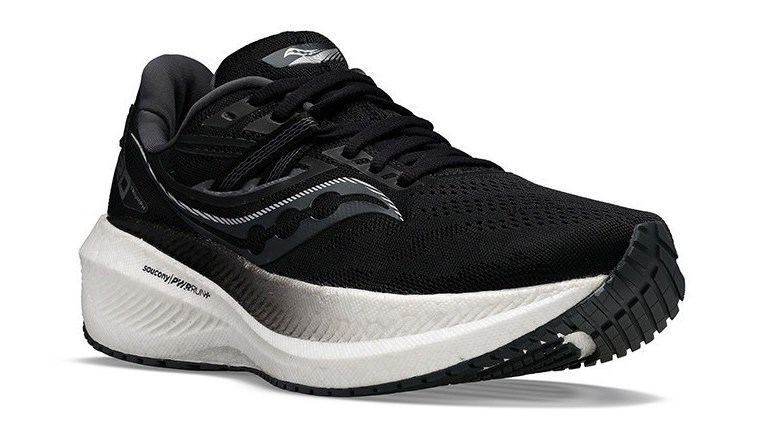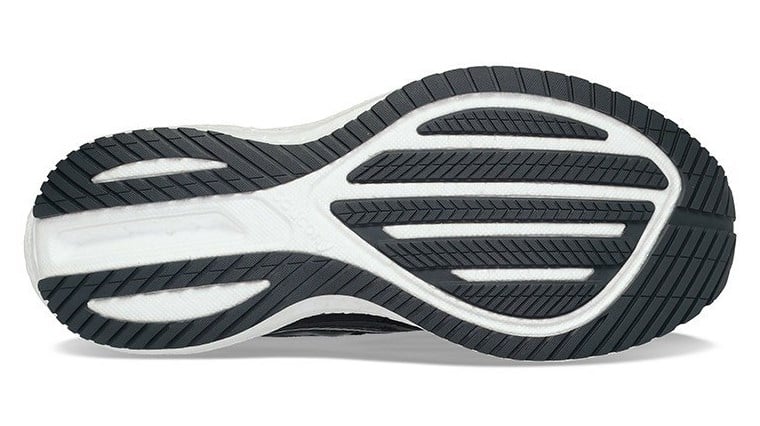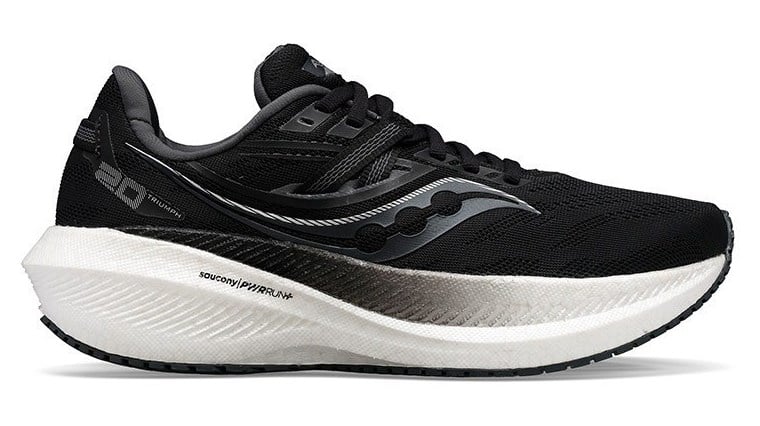Saucony Triumph 20 vs 19 Comparison Running Shoe Review

The main difference between the Saucony Triumph 20 and the Saucony Triumph 19 is that the Triumph 20 is on a slightly elevated stack height with a 10mm heel-to-toe drop, while the Triumph 19 is on an 8mm heel-to-toe drop.
This may not sound like a big change, but it is when you consider Saucony's engineering philosophy over the past decade has been to stay true to the 8mm heel-to-toe drop and not create any shoes that are elevated higher than this. In his review of the Saucony Triumph 20, Josh Willoughby explains why Saucony have broken their rule and weighs in on how this effects the overall performance of this running shoe.
The Saucony Triumph 20 continues to be a go-to high mileage daily trainer – meaning comfort has been prioritised in all aspects of its engineering, yet it’s versatile enough to shift the pace up the gear when you’re craving more snap and speed.
This stable neutral running shoe is lighter than its predecessor without compromise to support and protection. Breathable engineered mesh wraps your feet to breeze through your training and the foam on the heel collar provides a secure rearfoot fit, making heel slippage a thing of the past.
PWRRUN+ technology sets you up on a resilient midsole to provide protection while being able to handle frequent use as part of your everyday training. The outsole has been refined to reduce weight and features strategically placed flex grooves to create a smooth rolling motion as you flow into your next stride.
Check out the full review with transcript below.
Hey guys, welcome to Sportitude Running, my name is Josh and we're going to be doing a shoe review today.
It’s extremely exciting, I was lucky enough to test this shoe around six months ago before it came to market here in Australia. I'm talking about the shoe right in front of me, the Saucony Triumph 20.
It's been a favourite here at Sportitude and at number of other running stores across the globe as a go-to daily trainer for those seeking plenty of cushioning for their long runs out on the road.
They’re stable neutral regarding their overall support system, so this running shoe is targeting that runner that doesn't have any tendency to favour the medial side of their gait cycle and if anything, they're maybe a mild supinator.
It is dialled in for that neutral to stable neutral foot type and if you don't know who that is, check out What Type Of Running Shoe Is Best For Me? and we'll take you through to a video we've done previously in identifying foot types.
As I touched on, it’s a very cushioned daily trainer. There's a lot of exciting things about this shoe which I'm excited to get to in today's review.
Today's review will go over all the key aspects of the outsole, midsole and the upper, compare it to where it was last year and give you all the information you need at home to potentially make this your next daily trainer shoe purchase. Without further ado let's get stuck in.
Runner Profile
The Saucony Triumph 20 is a daily trainer. It is your easy day shoe for the time spent out on the road where you go out, switch off, listen to your podcast and you're just turning your legs over nice and easily at a cruisy heart rate level. It is a shoe that's very comfortable and it's not an overly complicated shoe regarding its performance.
It's lighter than what it was previously, however it is a shoe that has plenty of support and protection underneath the body. This is going to fit in your shoe rotation as a daily trainer.
We’re not saying you can't do a progressive run or a tempo run in it because you can, it's has a really light and snappy feel. However, this has really been targeted for your miles out on the road.
Upper

Let's jump into the fun part of this review and start talking about the engineering. I'm going to reverse it a little bit and I'm going to start with the upper first.
When you have a performance shoe, obviously it's designed to spend plenty of kilometres out on the road. That usually means there's going to be a bit of swelling and additional reliance on ventilation with regards to your running shoe.
Looking at the Saucony Triumph 20, you can see through the front half we have the engineered mesh. It's a really nice executed upper so you get plenty of ventilation through the toe box region and the tongue area. You want to get as much airflow into this shoe as you possibly can without sacrificing too much support.
The other great thing or great feature of the shoe in comparison to where it was last year is the additional attention they have put in regarding locking that navicular or arch down. With last year’s model we had on the instep a good gusseted construction, so the medial and lateral side of that tongue did come down to the midsole and give you a really secure fit.
If anything, the tongue is the same thickness in the Saucony Triumph 20. However, Saucony have addressed this little eyelet at the top so you get the same conformed fit on the medial side as you do the lateral side. It's just a different way of executing that outcome.
Coming back to the heel counter of this shoe, being a mileage shoe, you would expect to have plenty of support at the back half for those heel strikers that come down. Your heel counter is secured with a really good construction around the internal features of this shoe.
The same thing goes as last year. There wasn't a real difference regarding the execution from the Saucony Triumph 20 to the Saucony Triumph 19 - a good solid heel counter was on play as well.
The only real change is the execution of the foam on the inside of the heel collar. I feel they've really addressed the overall comfort of this shoe and improved the fit around the heel as well. They have a different material at the back to ensure that we don't get any unnecessary heel lift through the exit of your gait cycle.
Outsole

We're going to jump down to the bottom and talk all things outsole. The role of the outsole is quite simple, it's there to protect the midsole to make sure it can hold up with regards to longevity and obviously give you a little bit of grip on the terrain it’s designed for.
Being a mileage shoe, it's designed for bitumen and pavement running. There’s going to be a fair bit of friction on play. When you talk about the outsole you want to make sure you have as much coverage as you can possibly get.
First things first, the XT-900 outsole is a blown rubber configuration that Saucony have used now for a number of years and they also use it across the majority of their high performance running shoes.
There’s been a little bit of change from the Saucony Triumph 19 to the Saucony Triumph 20. The first things you can probably pick up on is there's less outsole on offer in the Saucony Triumph 20.
That’s going to reduce a little bit of the weight of the shoe which is in some cases a good thing but not always an absolute necessity when you're talking about high-end max cushioned mileage shoes. You're not buying them because they're light, but a little bit of rate reduction in areas you can sacrifice is A-OK and that's exactly what's on offer.
There’s good surface area coverage and it still has a little bit of that decoupled line which was on offer in the Saucony Triumph 19 as well as the Saucony Triumph 20. It isn’t quite as deep, it’s a little bit shallower and more dialled in towards the back of the shoe.
Where they have probably not sacrificed regarding that weight reduction, they've reduced the amount of total surface area and coverage. It's a bit like some of their performance shoes like the Saucony Endorphin Speed.
You can see there's a bit of a trend regarding getting that vertical line right through the front half of the forefoot. It creates and encourages that little bit of a roll through your toe-off, almost that rocker sole or that SPEEDROLL which they call out in the Saucony Endorphin Speeds. We get that really smooth exit out of the gait cycle and that's executed in the Saucony Triumph 20 with the flex grooves running the vertical line throughout the shoe.
Midsole

Let’s jump into the fun part of this review. I'm going to talk all things midsole because that is where most of the discussion points are with this shoe. There's quite the change regarding where this Saucony Triumph 20 sits.
Let's talk about the foam itself. Saucony are using their PWRRUN+ technology which is a TPU-based midsole. It’s a pretty similar fit and feel to what they have rolled out in their Saucony Endorphin Speed and their Saucony Endorphin Pro, however that is the PWRRUN PB, their polyurethane based midsole. It’s quite different regarding its overall performance. Having a TPU-based midsole means the Saucony Triumph 20 is going to be a little bit more resilient and it's going to last a fraction longer.
The other big discussion point with the Saucony Triumph 20 is the stack height. For the best part of 10 years Saucony have stuck to their guns, believed in their engineering philosophy and have not made any Saucony running shoes over an 8mm heel-to-toe drop.
This year the Saucony Triumph 20 has bucked that rule and they've gone to a 10mm heel-to-toe offset. We have 37mm in the heel and 27mm in the forefoot for that variance of 10mm.To give you some context, last year's Saucony Triumph 19 had a 32mm heel and a 24mm forefoot for that variance of 8mm.
Why have they done such a drastic thing and changed what they have believed in for the best part of a decade?
We and Saucony believe that to have a progressive midsole technology like your PWRRUN+, you need to make sure that the offset and the stack height is complementing what it does regarding its overall performance, cushioning and energy return.
I believe if this shoe was on an 8mm heel-to-toe drop, it would not be as sustainable and it would not perform as well as it does now being on that 10mm heel-to-toe drop. Your entry point of this shoe for a heel striker is going to get a bit more compression on that lateral side. Therefore, it's going to compress around about the same amount as you would get out of last season's models, be it the Saucony Triumph 19 or the Saucony Triumph 18, being a softer feel underneath the foot.
It's important to note that while the actual static measurement of this shoe is 10mm high, the overall performance may be pretty similar to where it was last year. I don't think brands like to recreate the wheel too much, but know that the performance of this midsole is just as good if not better in my opinion in the Saucony Triumph 20 in comparison to where it was in last year's Saucony Triumph 19.
The other thing to note which we touched on in the intro is it is a neutral shoe. On the medial side of this shoe there's no guidance or progressive support established there. It is the same density on this side as it is on the lateral side which again is going to complement and be the perfect fit, feel and performance for that neutral to mildly supinated runner out there. Being a mild overpronator, I have had great success and I've loved running in this shoe.
The Wrap Up

In summary, the Saucony Triumph 20 is in my opinion one of the best updates so far of 2022. We are in September now and obviously it has taken a long time for us to make that call, but the reason I've made that call is because I had a pair about six to seven months ago. Saucony was kind enough to send me one of the prototypes of this shoe and it was the pre-production prototype.
What we see in the prototype is exactly what got delivered to us with the Saucony Triumph 20. What I found with this shoe from the get-go is the performance was a plus. Sometimes with mileage shoes you have to break them in a little bit. You have to take them for a bit of a run, you have to try and figure out its characteristics and whether it complements you as a runner.
I don’t have any issues whatsoever with this running shoe. I'm a midfoot runner and I'm a mild overpronator, so I found the support in this shoe to be just fine. It supported me in the right areas, hugged me in the right spots. I am the same size in this running shoe as I was in last year's Saucony Triumph 19 and that was a US 9 in a standard D width. The reason I've called this one of the best updates of the year is because where it's come from regarding the Saucony Triumph 19. It's marginally lighter, it has a better performing midsole and it's a more versatile shoe.
Yes, it's a mileage shoe and it's designed to spend plenty of kilometres out on the road. However, I could easily use this shoe for a progressive run or even a session if I was feeling a bit sore and I wanted more cushioning and support out of my shoe when I hit the ground at more velocity and a higher pace.
The Saucony Triumph 19’s journey over the last couple of seasons has been very well noted. From the Saucony Triumph 18 vs Saucony Triumph 19 and now the Saucony Triumph 20, this brand and this franchise is on the right track. They're really making some great shoes out there and the other added benefit is it's available in widths.
I say it all the time with my shoe reviews, when brands commit to making a width for you the runners out there that means they care. They believe in their engineering and they want to make that shoe more accessible for you the running market.
In the men’s width a standard D width and wide 2E is on offer and in the women’s model a standard B width and wide D width is on offer. It complements exactly what this shoe is all about.
If you have any questions on the Saucony Triumph 20 or if you have come from a different shoe and are questioning whether this should be one you consider, please contact our Sportitude shoe experts.
To give you some context, if you have had a Brooks Glycerin, Asics Gel Nimbus 24 or even the Nike Air Zoom Vomero, they're a few shoes that you can throw into the same category in conversation as your Saucony Triumph 20.
Thank you so much for watching. If you haven’t yet subscribed to the Sportitude YouTube channel, please hit that subscribe button to stay notified and we'll keep pumping out the shoe reviews for you the running community all over the world.
Until next time, stay safe be kind to one another, happy training and we'll see you on the road take care.
FEATURES
- Support: Neutral
- Upper: Mesh
- Midsole: Saucony PWRRUN+
- Heel Height: 35mm
- Forefoot Height: 25mm
- Offset / Drop: 10mm
Men
- Weight: 275g / 9.7oz
- Width: D (standard), 2E (wide)
Women
- Weight: 249g / 8.8oz
- Width: B (standard), D (wide)
Saucony Triumph 19
Please subscribe to the Sportitude YouTube channel to stay updated on all things running shoes.
For a more in-depth shoe fitting experience, you can book a free 15 minute video chat in a Live Fit session or make an appointment to discover your RunDNA at Sportitude Running@Hindmarsh.
Happy running!
